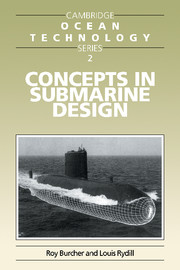Book contents
- Frontmatter
- Contents
- Introduction
- Acknowledgements
- 1 Design in general
- 2 Milestones in submarine history
- 3 Submarine hydrostatics
- 4 The weight/space relationship
- 5 Submarine structures
- 6 Powering of submarines
- 7 Geometric form and arrangements
- 8 Dynamics and control
- 9 Submarine systems
- 10 Considerations of building and costs in design
- 11 Generating a concept design
- Appendix 1 Hydrostatic conditions of flotation
- Appendix 2 Operational practice for keeping in trim
- Appendix 3 Assessing weight and size of variable ballast
- Appendix 4 Submarine pressure hull strength (Prediction of interframe collapse pressures)
- Appendix 5 Estimates of resistance and propulsion
- References and suggested reading
- Index
11 - Generating a concept design
Published online by Cambridge University Press: 05 July 2014
- Frontmatter
- Contents
- Introduction
- Acknowledgements
- 1 Design in general
- 2 Milestones in submarine history
- 3 Submarine hydrostatics
- 4 The weight/space relationship
- 5 Submarine structures
- 6 Powering of submarines
- 7 Geometric form and arrangements
- 8 Dynamics and control
- 9 Submarine systems
- 10 Considerations of building and costs in design
- 11 Generating a concept design
- Appendix 1 Hydrostatic conditions of flotation
- Appendix 2 Operational practice for keeping in trim
- Appendix 3 Assessing weight and size of variable ballast
- Appendix 4 Submarine pressure hull strength (Prediction of interframe collapse pressures)
- Appendix 5 Estimates of resistance and propulsion
- References and suggested reading
- Index
Summary
INTRODUCTION
11.1 It can be recognised that throughout the book we have placed emphasis on conceptual formulation in submarine design and on the high level of interaction between the sub-systems. It must nevertheless be appreciated that the successful outcome of a submarine design is ultimately achieved by extensive detailed study of every aspect of the design. It is only by detailed studies that the multitude of interaction effects can be identified and resolved. However, such studies have to be conducted within a framework which adequately defines the total design and that is the purpose of the Concept Design phase. The objective is to determine a size and weight plus geometric configuration within which the detailed studies (often conducted by specialist designers) can take place. For example, there is little point in conducting a detailed design of pressure hull structure if the envisaged configuration of the hull precludes achievement of a weight/buoyancy and longitudinal balance. Similarly, there is little point in a detailed investigation of the weapon compartment layout and tankage if its location within the hull is inconsistent with the fore-end configuration.
11.2 Consequently, the designer has to be able to determine the broad design characteristics having an awareness of the details that must follow. He is unlikely to have much information on those details, particularly in an innovative design, but he must endeavour to ensure that the subsequent stages are capable of achievement.
Information
- Type
- Chapter
- Information
- Concepts in Submarine Design , pp. 241 - 275Publisher: Cambridge University PressPrint publication year: 1994
